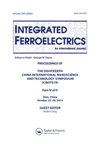bi2o3掺杂20Li 2o - 40v 2o - 20b2o -20ZnO热电玻璃的结构和电学特性研究
IF 0.7
4区 工程技术
Q4 ENGINEERING, ELECTRICAL & ELECTRONIC
引用次数: 0
摘要
摘要采用传统的熔体猝灭法制备了Bi2Te3掺杂量分别为0、5、10、15、20和25的20Li2O-40V2O5-20B2O3-20ZnO (LVBZ)系列热电玻璃。为了发现热电玻璃的潜力,我们对一系列样品进行了全面的研究,使用了多种方法来分析它们的结构和电性能。该结构符合x射线衍射(XRD)分析和成分调查的结果。结果表明,随着Bi2Te3掺杂浓度的增加,LiV3O8相内的强度降低,从而对热电性能产生影响。在掺量为25 wt%时,密度值最高,为3.17 g/cm3。利用ZEM-3系列仪器对样品的热电性能进行了测试。半导体材料的性能表现为电阻率值的不断下降。n型热电材料分类用验证的塞贝克系数值表示。在所测试的样品中,按重量计掺入15% Bi2Te3的LVBZ在该系列中表现出最高的电性能,在668 K时功率因数为0.07 μ W/mK2。通过对功率因数的测定,得出电导率随测试温度的升高而升高的结论。作者要感谢Sakon Nakhon Rajabhat大学研究与发展机构替代能源卓越中心热电研究实验室对热电性能的测量。感谢NPRU研究与发展研究所提供的设施。K. Boonin和J. Kaewkhao感谢泰国国家研究理事会(NRCT)和泰国科学研究与创新(TSRI)对这项研究的支持。披露声明作者未报告潜在的利益冲突。本项目由泰国国家研究委员会(NRCT)和TENSOR PRODUCTS LIMITED PARTNERSHIP资助,项目编号N41A650415。本文章由计算机程序翻译,如有差异,请以英文原文为准。
Investigation of the Structural and Electrical Characteristics of Thermoelectric Glass 20Li 2 O-40V 2 O 5 -20B 2 O 3 -20ZnO with Bi 2 Te 3 Doping
AbstractThe conventional melt-quenching synthesis was used to produce a series of thermoelectric glasses with the compositions 20Li2O-40V2O5-20B2O3-20ZnO (LVBZ) with Bi2Te3 doping as a percentage is 0, 5, 10, 15, 20, and 25 by weight. To discover the potential of thermoelectric glass, a comprehensive study was conducted on a series of samples using a combination of methods for analyzing both their structural and electrical properties. The structure exhibits the findings of the X-ray diffraction (XRD) analysis compositional investigation. It was discovered that the intensity within the LiV3O8 phase decreased with increasing dopant Bi2Te3 concentration, which produced an impact on the thermoelectric properties. The density value highest at 25 wt% doping and was 3.17 g/cm3. Furthermore, the thermoelectric properties of the samples were examined using ZEM-3 series instruments. The behavior of the semiconductor material is represented by the continual decrease in electrical resistivity value. The N-type thermoelectric material classification is represented by the verified Seebeck coefficient value. Out of the samples tested, the LVBZ with 15% Bi2Te3 doping by weight demonstrated the highest electrical performance in this series, with a power factor of 0.07 µW/mK2 at 668 K. The examined power factor values lead to the conclusion that the result of electrical conductivity increases with testing temperature.Keywords: Wordmelt-quenchingthermoelectric glasspower factor AcknowledgmentsThe authors would like to thanks Thermoelectric Research Laboratory, Center of Excellence on Alternative Energy, Research and Development Institution, Sakon Nakhon Rajabhat University for thermoelectric properties measurements. Thanks, are also due to Research and Development Institute, NPRU for facilities. K. Boonin and J. Kaewkhao would like to thanks National Research Council of Thailand (NRCT) and Thailand Science Research and Innovation (TSRI) for supporting this research.Disclosure StatementNo potential conflict of interest was reported by the author(s).Additional informationFundingThis project was funded by National Research Council of Thailand (NRCT) and TENSOR PRODUCTS LIMITED PARTNERSHIP for project number N41A650415.
求助全文
通过发布文献求助,成功后即可免费获取论文全文。
去求助
来源期刊

Integrated Ferroelectrics
工程技术-工程:电子与电气
CiteScore
1.40
自引率
0.00%
发文量
179
审稿时长
3 months
期刊介绍:
Integrated Ferroelectrics provides an international, interdisciplinary forum for electronic engineers and physicists as well as process and systems engineers, ceramicists, and chemists who are involved in research, design, development, manufacturing and utilization of integrated ferroelectric devices. Such devices unite ferroelectric films and semiconductor integrated circuit chips. The result is a new family of electronic devices, which combine the unique nonvolatile memory, pyroelectric, piezoelectric, photorefractive, radiation-hard, acoustic and/or dielectric properties of ferroelectric materials with the dynamic memory, logic and/or amplification properties and miniaturization and low-cost advantages of semiconductor i.c. technology.
 求助内容:
求助内容: 应助结果提醒方式:
应助结果提醒方式:


